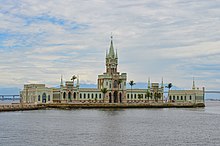You can help expand this article with text translated from the corresponding article in Portuguese. (December 2010) Click [show] for important translation instructions.
|
Ilha Fiscal, or Fiscal Island, is an island in Guanabara Bay, bordering the historic city center of Rio de Janeiro, in southeastern Brazil.

Originally named by Europeans as Rat Island (Portuguese: Ilha dos Ratos), its current name comes from the fact that the customs department has been stationed there before Guarda Fiscal, serving the port of the then-capital of the Empire during the nineteenth century. The customs offices were housed at a Neo-Gothic palace built under Pedro II,[a] which occupies most of the island. The island became famous as the site of the famous Fiscal Island Ball (Portuguese: Baile da Ilha Fiscal), the last royal ball of the Empire before the coup d'état that proclaimed the Republic in November 1889.[1]
History
editThe New York Times' Marlise Simons considers the former-Customs House a "preposterous neo-Gothic edifice of green turrets."[2]
During the Fiscal Island Ball (Portuguese: Baile da Ilha Fiscal), held on 9 November 1889[b] and considered "the last ball of the Empire," Afonso Celso, Viscount of Ouro Preto, Deodato Cesino Vilella dos Santos, João da Costa Lima e Castro and Saldanha da Gama were members of the reception committee.[3] The ball was in honor of a visiting Chilean delegation[4] of naval men,[5] with an alleged attendance of six thousand guests.[4] An often repeated legend states that after the ball 8 bodices, 17 silk pillows, 3 corsets, 17 garters and 9 epaulets were found on the island.[2]
During the Revolt of the Lash, on 23 November 1910, the Brazilian battleship São Paulo was located off the island and headed out of the bay unscathed.[6] Aurélio de Figueiredo painted The Last Dance of Ilha Fiscal (Portuguese: O Último baile da Ilha Fiscal), based on the 1889 ball, in 1905.[7] Since 1914, the Navy's Directorate of Hydrography and Navigation (Portuguese: Diretoria de Hidrografia e Navegação) has been based on Ilha Fiscal. After the Oceanographic Institute of the University of São Paulo, the Directorate was the second institution in Brazil to carry out oceanographic research.[8] Monica Hirst argumented before the meeting that resulted in the 1994 Protocol of Ouro Preto that it should not be compared to the Ilha Fiscal Ball.[9] In 2002, businessman Alexandre Accioly celebrated his 40th birthday at Ilha Fiscal.[10] As part of the 2005 Rio Fashion Week, designer Clara Vasconcelos showcased the Tessuti 2006 summer collection runway show held on a runway with 150 seat capacity in the form of an "A".[11][12][13] During the Mensalão scandal, presidential advisor Ricardo Kotscho made a public statement which Folha de S.Paulo journalist Clóvis Rossi compared to the infamous ball, "where the court danced while the monarchy collapsed."[14]
Ilha Fiscal now hosts a museum of cultural history housed in the that is maintained by the Navy of Brazil. Boat and land tours depart the nearby Navy Cultural Center and travel to and around Ilha Fiscal.[1]
See also
editNotes
editReferences
edit- ^ a b Waggoner, John (2008). Brazil Travel Adventures. Hunter Publishing. p. 113. ISBN 9781588436764. Retrieved 9 November 2021 – via ProQuest.
- ^ a b Simons, Marlise (7 October 1984). "Haunts and Hangouts". The New York Times. ISSN 0362-4331. Archived from the original on 24 May 2015. Retrieved 9 November 2021.
- ^ Needell, Jeffrey David (1982). "Chapter III High Society and the Salon". The Origins of the Carioca Belle Epoque: The Emergence of the Elite Culture and Society of Turn-of-the-century Rio de Janeiro. Stanford University. pp. 197 (239). Archived from the original on 9 November 2021. Retrieved 9 November 2021 – via ProQuest.
- ^ a b Trochim, Michael Robert (1983). Retreat from Reform: The Fall of the Brazilian Empire, 1888-1889. University of Illinois at Chicago. pp. 303 (313). Archived from the original on 9 November 2021. Retrieved 9 November 2021 – via ProQuest.
- ^ Simmons, Charles Willis (1997). Marechal Deodoro and the Fall of Dom Pedro II. University of Illinois at Urbana-Champaign. pp. 147 (152). Archived from the original on 9 November 2021. Retrieved 9 November 2021 – via ProQuest.
- ^ Love, Joseph (2012). "The Rebellion and its Resolution". The Revolt of the Whip. Stanford University Press. pp. 50–51. ISBN 9780804783699. Retrieved 9 November 2021 – via ProQuest.
- ^ Williams, Daryle (1995). Making Brazil modern: Political culture and cultural politics under Getulio Vargas, 1930-1945. Stanford University. pp. 96 (111). Archived from the original on 9 November 2021. Retrieved 9 November 2021 – via ProQuest.
- ^ Sedrez, Lise Fernanda (2005). "To Protect and Defend: The Navy". 'The bay of all beauties': State and environment in Guanabara Bay, Rio de Janeiro, Brazil, 1875–1975. Stanford University. pp. 139 (155). Archived from the original on 9 November 2021. Retrieved 9 November 2021 – via ProQuest.
- ^ Hirst, Monica (15 December 2004). "Opiniao- O impasse Brasil-Argentina" [Opinion- The Brazil-Argentina impasse]. Valor Econômico - Globo (in Portuguese). Retrieved 9 November 2021 – via ProQuest.
- ^ Franco, Carlos (11 April 2005). "Empresarios investem em novos projetos" [Entrepreneurs Invest in New Projects]. Jornal do Comércio (in Portuguese). Retrieved 9 November 2021 – via ProQuest.
- ^ "Restaurante do Eike" [Eike's Restaurant]. O Globo (in Portuguese). Rio de Janeiro. 8 June 2005. Retrieved 10 November 2021 – via ProQuest.
- ^ "Tudo novo de novo" [Everything New Again]. O Globo (in Portuguese). 11 June 2005. Retrieved 10 November 2021 – via ProQuest.
- ^ "Fashion Rio: Evento abriga anos 70 e universo circense" [Fashion Rio: Event hosts the 70s and the circus universe]. Folha de S.Paulo (in Portuguese). 16 June 2005. Retrieved 10 November 2021 – via ProQuest.
- ^ Rossi, Clóvis (16 June 2005). "Clóvis Rossi: Ilha Fiscal, de novo?" [Clóvis Rossi: Ilha Fiscal, Again?]. Folha de S.Paulo (in Portuguese). Retrieved 11 November 2021 – via ProQuest.